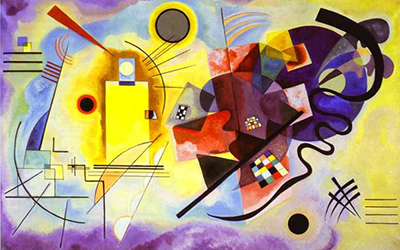Wassily Kandinsky was born in Moscow in 1866 and is best known for his bold, abstract paintings which celebrate colour and form.
Although inspired by music, colour and the creative artistic movements developing during that time, Kandinsky took up painting much later in life and his early works included a number of landscapes and outdoor scenes, but even then his love of colour and exquisite use of tone and hue were prevalent.
Renowned artists such as Cezanne, Gauguin and Matisse were all painting at this time and revolutionising art with the introduction of impressionism in a variety of forms.
Many of the Impressionists shunned the use of black, instead creating depth of form and shadow by combining or applying darker hues together. Kandinsky had seen the development of pointillism as well as the cubism movement and there are elements of these influences in many of his works.
Yellow, Red, Blue, painted in 1925, is arguably one of his best-loved works and was produced during the period when Kandinsky prolifically explored abstract compositions of geometric shapes and bright colours, many of which were large-scale pieces.
Predominantly depicting the three primary colours, Yellow, Red, Blue transports the viewer through a spectrum of complementary secondary hues and leads the eye on a wonderful journey of discovery and ever-changing direction, from straight lines to curves and waves, all of which meander or strike dynamically through light and shade.
The freedom of form and colour as well as the arrangement of shapes depicted here could easily be mistaken for random placement, but composition was extremely important to Kandinsky and in the execution of his abstract paintings, there is always the element of balance.
Spend a few moments considering Yellow, Red, Blue and this balance becomes more apparent. The left side of the painting basically comprises golds and yellows on a background of blues and purples, while the right-hand side of the painting is effectively the opposite. The transition between the two is constructed so that the eye is guided from left to right, but as the viewer travels through the images, the eye is then led around the painting by the placement of circles and diagonals which continue the movement around the canvas until every aspect has been explored. Where there is light, there is shade; where there is order, there is freedom; where there is definition, there is obscurity.
Note the ordered, chequered squares with their geometric conformity able to maintain their place within the composition because they are balanced by the squares above, as well as comprising smaller squares which complement the colour palette of the painting.
In Yellow, Red, Blue, it is almost as if music has been interpreted in visual form and music certainly influenced Kandinsky creatively. As with music, which can stir and inspire the soul and mean different things to different people, a painted image can also be evocative depending how it is received visually and psychologically. Kandinsky understood that art could affect people emotionally and spiritually and that this didn’t necessarily mean it should involve recognisable images.
Kandinksy believed that art was as much for the soul as the eye and sought to provoke an emotional reaction or even a connection between the viewer and the painting. Rather than challenge the viewer, Kandinsky invites the viewer to respond to the images before them; to allow their own interpretation or feelings and indulge their senses in the composition on the canvas.
Yellow, Red, Blue is painted in oils and measures 1.27m x 2m. It is currently housed in the Musee National d’Art Moderne at the Pompidou Centre in Paris.




